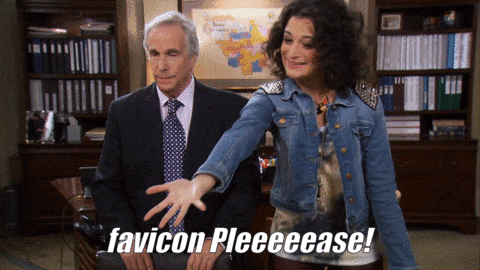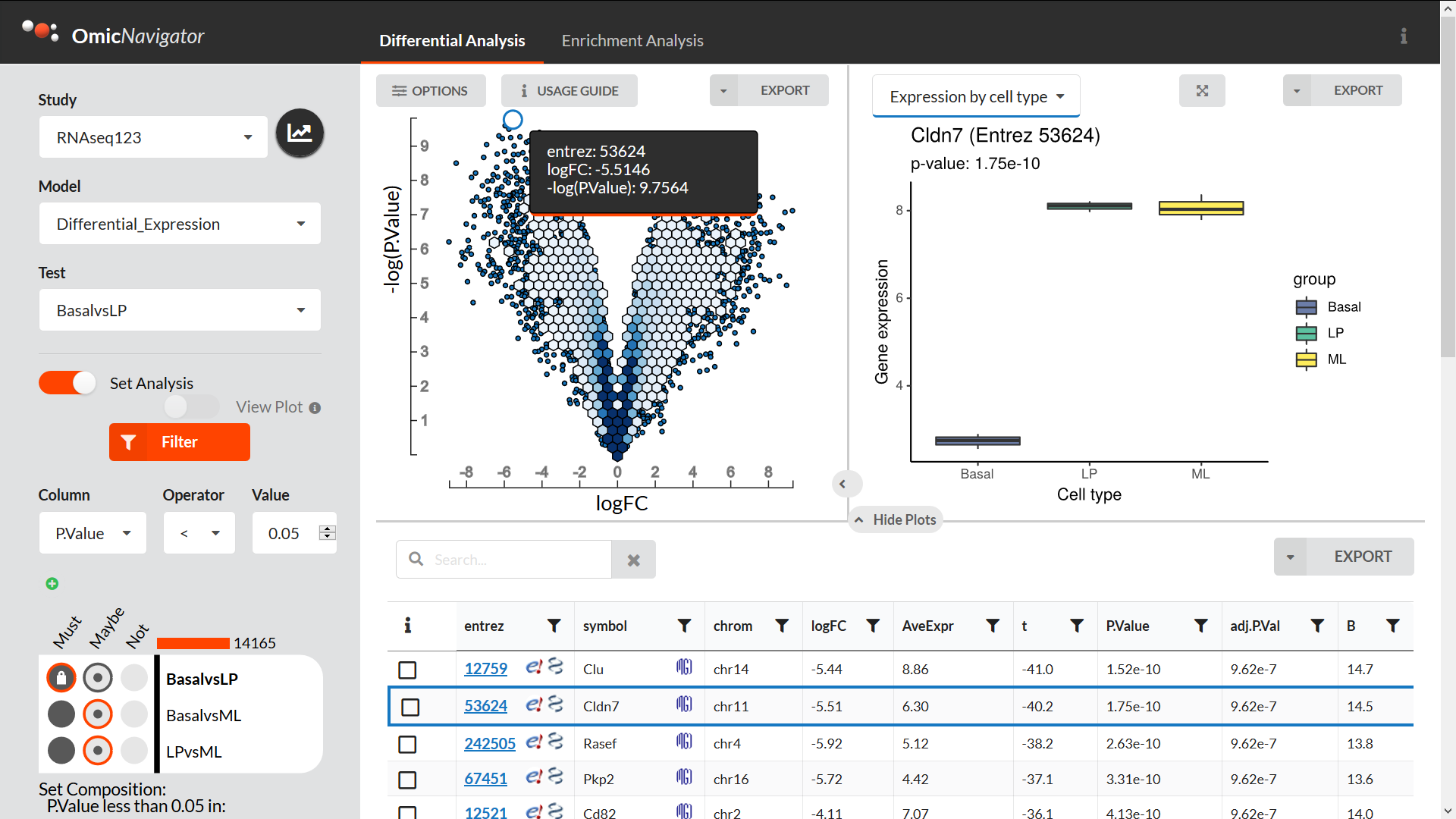tl;dr The R package faviconPlease returns the URL to the favicon file for any website. Also available to install from CRAN

Motivation
For the OmicNavigator web app I helped develop (see my previous blog post), we allow the user to include external linkouts for more information on the features (see example screenshot below), e.g. a link to the Ensembl page for each gene. In order to make the display appealing and intuitive, we wanted to display the links using each website’s unique favicon. Since we don’t know in advance which external resources a user will include, we needed a general solution that could obtain a favicon for any website.

My initial plan was to use a 3rd party service to obtain the favicon to display. Search engine providers like Google and DuckDuckGo display the favicon for each site in their search results, and they conveniently provide an API for others to query their favicon databases. Frustratingly though, the coverage was not as good as I had anticipated, especially for the scientific websites our users were likely to need. And the availability changes over time. Some examples from back when I was originally writing the package: 1) DuckDuckGo had the favicon for GitHub but not Google, and 2) Google had the favicon for AmiGO but not DuckDuckGo. The last time I checked though both services provide favicons for GitHub and AmiGO.
- GitHub’s favicon
- AmiGo’s favicon
Fortunately though they both provide a generic favicon to insert when they don’t have the favicon:
DuckDuckGo
Google
Another big limitation is that the search engine providers only have favicons available for publicly accessible websites. If you have internal websites with their own favicons, this requires a more involved approach.
Next I looked for available open source favicon-grabber software. As expected, these are mainly written in more web-oriented programming languages like JavaScript and PHP.
Grabbing the favicon mainly involves parsing HTML and/or downloading files, which R can handle, so I decided to create a favicon-grabber for R: faviconPlease!
How favicons work
From the mdn web docs:
A favicon (favorite icon) is a tiny icon included along with a website, which is displayed in places like the browser’s address bar, page tabs and bookmarks menu.
The default option for a website to display a favicon in a web browser tab is to provide the file favicon.ico at the root of the web server. If every web site used this option, then finding favicons would be trivial. Unfortunately there are many ways to configure a favicon.
When a website doesn’t provide favicon.ico, they often specify the favicon file with a <link> element in the <head> of the file. The rel attribute is set to either "icon" or "shortcut icon".
<link rel="icon" href="path/to/favicon.ico">
<link rel="shortcut icon" href="path/to/favicon.ico">This also isn’t too bad. You can parse the HTML and then query with XPath to obtain the URL.
A big challenge is that the href attribute with the path to the file can be specified in so many different ways:
<!-- absolute: the full URL to the file -->
<link rel="icon" href="https://example.com/path/to/favicon.ico">
<!-- protocol-relative - everything but the http(s) -->
<link rel="icon" href="//othersite.com/path/to/favicon.ico">
<!-- root-relative - relative to the root of the server, as opposed to the current file -->
<link rel="icon" href="/path/to/favicon.ico">
<!-- relative - relative to the current file -->
<link rel="icon" href="path/to/favicon.ico">And an added twist is that relative paths can be globally modified by the base element:
The
HTML element specifies the base URL to use for all relative URLs in a document. There can be only one element in a document.
Implementation
My goal was to create a single function that abstracted away all of the above complexity. You pass a URL, and it returns a URL to a favicon you can use to display in your app. It’ll try various strategies to obtain a favicon, and fall back to one of the default favicons from DuckDuckGo or Google. Here’s an example:
library(faviconPlease)
faviconPlease("https://github.com/")
[1] "https://github.githubassets.com/favicons/favicon.svg"By default, faviconPlease() uses the following strategy to find the URL to the favicon for a given website. It stops once it finds a URL and returns it.
Download the HTML file and search its
<head>for any<link>elements withrel="icon"orrel="shortcut icon".Download the HTML file at the root of the server (i.e. discard the path) and search its
<head>for any<link>elements withrel="icon"orrel="shortcut icon".Attempt to download a file called
favicon.icoat the root of the server. This is the default location that a browser looks if the HTML file does not specify an alternative location in a<link>element. If the filefavicon.icois successfully downloaded, then this URL is returned.If the above steps fail, as a fallback, use the favicon service provided by the search engine DuckDuckGo, e.g. https://icons.duckduckgo.com/ip3/github.com.ico. This provides a nice default for websites that don’t have a favicon (or can’t be easily found).
I also wanted to make sure the function was extensible and customizable so that it could be useful to others without me having to implement every alternative strategy for finding favicons. To accomplish this, I took advantage of the feature that R has first-class functions. The argument functions accepts a list of functions to find a favicon URL. And the argument fallback accepts a single function that always returns a URL (e.g. from DuckDuckGo).
args(faviconPlease)
function (links, functions = list(faviconLink, faviconIco), fallback = faviconDuckDuckGo)
NULLThis way, if you instead wanted to first check for the existence of favicon.ico and use Google as a fallback, you could adjust the functions passed to faviconPlease. In the case of github.com, it does find a favicon.ico file.
library(faviconPlease)
faviconPlease("https://github.com/", functions = list(faviconIco, faviconLink),
fallback = faviconGoogle)
[1] "https://github.com/favicon.ico"Furthermore, if you wanted to create your own favicon search function, you could model it after faviconLink() and faviconIco(), and then pass it in the list of functions.
Challenges
The first challenge is that download.file() is not fool-proof. I first encountered this issue when trying to write workshop tutorials. A simple call to download.file() will fail in many different situations depending on the operating system. ?download.file recommends:
Setting the
methodshould be left to the end user.
And thus this is what I did, by exposing the argument method (and others) to pass from faviconIco() to download.file(). Fortunately it is also possible to control this behavior with a global option "download.file.method".
A second big challenge is security policies. As a primary example, Ubuntu 20.04 increased the default security restrictions when accessing web resources, and many websites haven’t updated their SSL certificates. This is one way the ability to create custom functions is useful. To use less-restrictive security policies, you can wrap the call to faviconIco() in a new function and specifically pass the flags --no-check-certificate and --ciphers=DEFAULT:@SECLEVEL=1 directly to wget.
faviconIcoUbuntu20 <- function(scheme, server, path) {
faviconIco(scheme, server, path, method = "wget",
extra = c("--no-check-certificate",
"--ciphers=DEFAULT:@SECLEVEL=1"))
}
Lastly, it’s a challenge to anticipate all the different ways a website may serve their favicon. If you find any websites that have a favicon but that faviconPlease() fails to find, please open an Issue so that I can potentially expand the support for more sites.
I downloaded the image from giphy.com and edited it with ezgif.com. I obviously have no rights to this image, so i guess “fair use”??↩